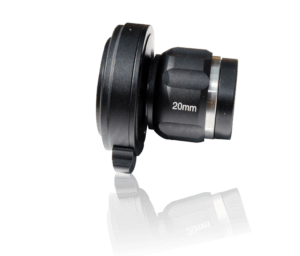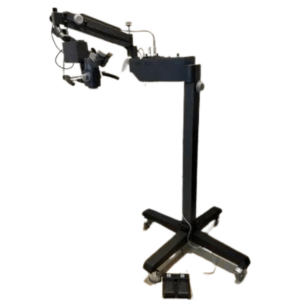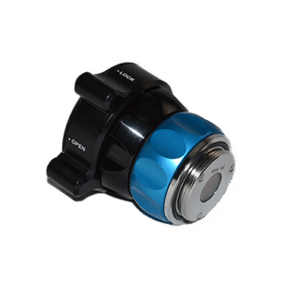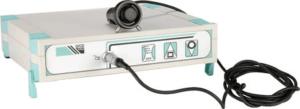Medical cameras serve as indispensable tools, providing healthcare professionals with the visual information they need to make informed decisions. This blog will take you on a journey through the realm of medical cameras, from selecting the ideal device to enhancing its capabilities and ensuring reliable performance. Along the way, we’ll also introduce Medzell, a futuristic B2B platform dedicated to promoting Indian medical devices in emerging markets.
Types of Medical Camera
Endoscopy Cameras
- These cameras are used in endoscopic procedures to visualize the inside of the body, such as the gastrointestinal tract, respiratory system, or joints.
- They come in various sizes and designs, including rigid and flexible endoscopes, with different illumination options, such as fiber optic or LED.
Microscopy Cameras
- Microscopy cameras are designed to capture high-resolution images and videos through microscopes.
- They are essential for research, diagnostics, and education in fields like pathology, microbiology, and cell biology.
Surgical Cameras
- Surgical cameras are used in operating rooms to document surgical procedures or assist in minimally invasive surgeries.
- They are often integrated into surgical instruments like laparoscopes or arthroscopes.
Dermatology Cameras
- These cameras are equipped with specialized lighting and optics to capture high-definition images of the skin and skin-related conditions.
- Dermatology cameras are valuable in dermatology clinics and cosmetic procedures.
Ophthalmic Cameras
- Ophthalmic cameras are used for imaging the eye and its various structures.
- Types include fundus cameras for capturing images of the retina, slit-lamp cameras for anterior segment examination, and confocal microscopy for corneal imaging.
Dental Cameras
- Dental cameras are designed for intraoral and extraoral imaging in dentistry.
- They help dentists visualize teeth and oral structures for diagnostics, treatment planning, and patient education.
Fluoroscopy Cameras
- Fluoroscopy cameras provide real-time X-ray images, making them suitable for procedures like angiography, cardiac catheterization, and orthopedic surgery.
- They enable continuous imaging during procedures.
Capsule Endoscopy Cameras
- Capsule endoscopy cameras are small, swallowable devices that capture images as they travel through the digestive tract.
- They are used to diagnose conditions in the small intestine that are hard to reach with traditional endoscopy.
Radiography and CT Cameras
- These cameras are used in radiology for capturing X-ray and CT scan images.
- They are crucial for diagnosing various medical conditions and planning treatments.
Infrared (IR) Cameras
- IR cameras capture thermal images of the body, helping diagnose conditions like inflammation, vascular issues, and temperature abnormalities.
Ultrasound Cameras
- While ultrasound primarily uses sound waves for imaging, cameras are sometimes used for recording and documenting ultrasound images and videos during diagnostic procedures.
Choosing the Right Surgical Medical Camera
When it comes to surgical procedures, choosing the right medical camera is crucial for capturing clear and precise visuals. The selection process involves considering several important factors that align with your specific surgical needs.
To ensure an informed choice when choosing a portable medical camera, it is vital to consider several factors. These include the dimensions, weight, battery capabilities, image quality, and ease of use of the device. By considering these factors, individuals can make a well-informed decision when choosing a portable medical camera. Taking into account these aspects allows for the selection of a camera that aligns with specific requirements and delivers optimal outcomes. Moreover, these considerations are crucial in ensuring accurate diagnosis and effective treatment during surgical procedures. Additionally, consider the camera’s low-light performance, as surgical environments often require optimal visibility.
Compatibility is another critical factor to consider. Ensure that the camera integrates seamlessly with your existing surgical equipment and software systems. This allows for efficient and streamlined workflows, eliminating any compatibility issues or workflow disruptions.
When choosing a portable medical camera, it is crucial to evaluate not just its technical specifications, but also its user-friendliness and ergonomic design for comfortable operation. Considering these aspects ensures a comprehensive assessment of the camera’s suitability for practical use.Surgical procedures require concentration and precision, so it’s essential to choose a camera that is comfortable to handle and easy to navigate.Prioritize ergonomic designs and intuitive controls that enable seamless focus on the task without unnecessary disruptions.
Lastly, consider the durability and reliability of the camera. Surgical environments can be demanding, with exposure to sterilization processes and potential accidental impacts. Select a camera that is rugged, resistant to environmental conditions, and built to withstand the challenges of the operating room.
Enhance Visualization with Endoscopic Cameras
Endoscopic cameras have revolutionized the field of medicine by enabling healthcare professionals to visualize internal organs and structures without invasive procedures. These cameras play a crucial role in enhancing visualization and improving procedural outcomes across various medical specialties.
Endoscopic cameras are specifically designed to navigate the complexities of the human body, capturing detailed visuals during minimally invasive surgeries and diagnostic procedures. By inserting a small camera through a tiny incision or natural body openings, surgeons can explore internal regions with precision and accuracy.
Endoscopic cameras offer a significant advantage by delivering magnified and high-definition imagery. This level of clarity allows surgeons to identify abnormalities, perform delicate maneuvers, and make informed decisions during procedures. Additionally, these cameras offer excellent illumination, ensuring optimal visibility even in challenging anatomical locations.
Endoscopic cameras find wide-ranging applications in various medical fields including gastroenterology, urology, gynecology, orthopedics, and more.Each specialty requires specific features and configurations tailored to their unique procedural requirements. When selecting an endoscopic camera, consider factors such as flexibility, maneuverability, and compatibility with specialized instruments and accessories.
High-Quality Dental Cameras for Enhanced Dentistry
Dental cameras have transformed the field of dentistry by providing detailed and precise imaging for diagnostic and treatment purposes. These high-quality cameras offer dentists a valuable tool for enhanced dentistry and improved patient care.
With dental cameras, dentists can capture high-resolution images of teeth, gums, and oral structures. This level of detail aids in the early detection of dental problems such as cavities, gum disease, and oral lesions. By identifying issues at their early stages, dentists can intervene promptly, leading to more effective and less invasive treatments.
The benefits of dental cameras extend beyond diagnosis. These cameras play a vital role in patient education and communication. By visually demonstrating dental conditions, dentists can effectively communicate treatment plans and engage patients in their oral health journey. Patients gain a better understanding of their oral health, leading to increased compliance with recommended treatments and preventive measures.
When choosing a dental camera, consider features such as image resolution, autofocus capabilities, and the ability to capture intraoral and extraoral images. Ergonomics and ease of use are also important factors, as dental procedures require precise handling and maneuverability.
Furthermore, dental cameras can be integrated with dental practice management software, allowing for seamless documentation, image storage, and patient record management. This integration streamlines workflows and enhances efficiency within the dental practice.
Features of Medical Camera
Understanding High-Resolution Cameras
High-resolution cameras have become a cornerstone of modern medical imaging. With their ability to capture images with exceptional clarity and detail, these cameras have transformed various medical specialties, from radiology to dermatology.
Within medical imaging, the term “resolution” pertains to the degree of detail that can be distinguished in an image. High-resolution cameras offer increased pixel density, resulting in sharper and more defined visuals. This level of detail is crucial for accurate diagnosis, treatment planning, and monitoring of patient conditions.
High-resolution cameras find extensive utility in the field of radiology, where they are deployed for imaging techniques such as X-rays, CT scans, and MRI scans.These cameras enable radiologists to detect minute abnormalities, analyze complex anatomical structures, and make precise measurements. High-resolution cameras contribute to earlier and more accurate diagnoses, leading to improved patient outcomes.
Dermatology is another field that greatly benefits from high-resolution cameras. These cameras allow dermatologists to capture detailed images of skin lesions, moles, and other dermatological conditions. By examining these images, dermatologists can accurately assess the severity of conditions, track changes over time, and evaluate treatment efficacy.
When assessing a high-resolution camera, it is crucial to give careful consideration to key factors such as sensor size, pixel count, and image processing capabilities. By taking these aspects into account, individuals can make well-informed decisions regarding the camera’s quality and performance. Larger sensors and increased pixel counts have a notable impact on enhancing resolution, while the utilization of advanced image processing algorithms contributes to superior image quality and effective noise reduction.Evaluating these factors is essential for ensuring optimal performance and image fidelity.
Applications of Medical Camera
Advanced Dermatology Imaging with Dermatology Cameras
Dermatology cameras have a significant impact on precise diagnoses and the evaluation of treatment outcomes in the field of dermatology. These sophisticated imaging devices provide specialized features and high-resolution capabilities, enabling dermatologists to capture intricate images of the skin, including moles, lesions, and various dermatological conditions.
The ability to capture images with exceptional clarity and detail is one of the key benefits of dermatology cameras. High-resolution sensors and advanced optics ensure that even the smallest nuances of the skin are accurately represented, aiding dermatologists in making precise diagnoses and tracking the progress of treatments over time.
Dermatology cameras also offer specialized lighting options that enhance the visibility of certain skin features. For example, polarized light can be used to eliminate glare and improve the visualization of superficial blood vessels.
Furthermore, dermatology cameras often come equipped with features such as magnification lenses and dermoscopic attachments.A dermatologist can use these tools to examine skin lesions, moles, and other dermatological abnormalities in depth, facilitating the detection of skin cancer and other skin diseases early on.
When selecting a dermatology camera, it is important to consider factors such as image resolution, lighting options, portability, and compatibility with existing dermatology software and systems. Additionally, ergonomic design and user-friendly interfaces contribute to a seamless and efficient imaging experience.
Clear Imaging for Veterinary Procedures
In veterinary medicine, clear imaging is crucial for accurate diagnosis and effective treatment of animals. Veterinary cameras provide veterinarians with the ability to visualize and capture high-quality images of animals’ anatomy, enabling precise examinations and aiding in surgical procedures.
When it comes to veterinary procedures, clear imaging is essential to identify and evaluate various conditions, such as fractures, tumors, internal injuries, and abnormalities in organs or tissues. Veterinary cameras equipped with high-resolution sensors and specialized optics allow for detailed visualization of these conditions, helping veterinarians make informed decisions about the most appropriate treatments.
Veterinary cameras come in different forms, including handheld devices, endoscopic cameras, and radiographic imaging systems. Each type serves specific purposes in different veterinary disciplines. For example, handheld cameras are versatile tools that can be used for general examinations, while endoscopic cameras allow for minimally invasive procedures and exploration of internal organs. Radiographic imaging systems provide detailed X-ray images for analyzing bone structure and identifying abnormalities.
The ability to capture clear images is especially important in veterinary dentistry, where dental cameras play a crucial role. These specialized cameras allow for detailed examination of the oral cavity, teeth, and gums, enabling veterinarians to detect dental issues such as cavities, gum disease, and oral tumors. Clear imaging in veterinary dentistry is essential for accurate diagnoses and effective treatment planning.
When selecting a veterinary camera, it is essential to consider factors such as image quality, ease of use, versatility, and compatibility with veterinary software systems. Additionally, durability and portability are crucial for veterinary professionals who need to conduct examinations in various settings.
Discover our range of high-quality veterinary cameras designed to provide clear imaging during veterinary procedures and examinations. Medzell offers a selection of veterinary imaging devices to meet the diverse needs of veterinary practices, enhancing the quality of care provided to animals.
Medical Camera from leading Indian Manufacturers
Endoscopy Coupler
Meditrax Equipments, a renowned medical camera manufacturer based in India, proudly presents the Endoscopy Coupler. Designed to meet the highest standards of quality and precision, this advanced device is set to transform the field of endoscopy.
The 4K coupler offered by Meditrax Equipments boasts an impressive range of sizes, including 18mm, 20mm, 22mm, 24mm, and 28mm. This versatility ensures compatibility with various endoscopic procedures, providing healthcare professionals with flexibility in their clinical practice.
Equipped with crystallized lenses, the Endoscopy Coupler delivers exceptional clarity and sharpness in image capture. This cutting-edge technology enables medical practitioners to visualize intricate details with remarkable precision, enhancing diagnostic accuracy and treatment planning.
One of the key advantages of the Endoscopy Coupler is its compatibility with all C-mount medical cameras. This seamless integration allows healthcare facilities to leverage their existing camera systems, eliminating the need for costly equipment upgrades. By simply attaching the coupler to their compatible cameras, medical professionals can immediately experience the enhanced imaging capabilities without any hassle.
The Endoscopy Coupler by Meditrax Equipments is engineered with a commitment to delivering superior image quality and reliability. With its robust construction and precise engineering, this device ensures consistent performance in the demanding environment of endoscopic procedures.
Meditrax Equipments, with its extensive expertise and reputation for excellence, has consistently been at the forefront of medical camera technology. The Endoscopy Coupler is a testament to their dedication to innovation and their mission to empower healthcare professionals with state-of-the-art equipment.
Ophthalmic Operating Microscope 5 Step
The Ophthalmic Operating Microscope 5 Step from A.S.F. Universal is a powerful and versatile device designed for precision and accuracy during ophthalmic procedures. With five stages of magnification incorporated into the design of the unit, this microscope allows for a comprehensive view of the surgical field.
One of the standout features of this ophthalmic operating microscope is its motorized microscope focusing mechanism. This allows for precise adjustments to be made to the focus of the microscope, ensuring that the surgeon can maintain an accurate view of the area of interest throughout the procedure. Additionally, the microscope is equipped with an LED lighting system, which provides bright and uniform illumination to the surgical site, improving visibility and facilitating accurate diagnosis and treatment.
The Ophthalmic Operating Microscope 5 Step from A.S.F. Universal is designed to be versatile and compatible with a range of surgical instruments and equipment. With its C-mount camera compatibility, the microscope can be easily integrated with medical cameras, enabling the capture of high-quality images and videos for documentation and analysis.
Constructed with the highest quality materials, this ophthalmic operating microscope is designed to be durable and long-lasting, capable of withstanding the rigors of regular use in a clinical setting. Its ergonomic design ensures that it is comfortable and easy to use, even during long and complex procedures.
UL-NZ1000 – Fixed Focal Length Camera Coupler
The UL-NZ1000 – Fixed Focal Length Camera Coupler from UnivLabs Technologies Pvt. Ltd. is a versatile and high-performance device designed to connect an endoscope to a surgical camera head. This Full HD C-Mount Coupler is available in multiple configurations, including C-Mount, Autoclavable C-Mount, and Rotating C-Mount, catering to different user preferences and requirements.
The Full HD C-Mount Coupler is custom-crafted to fulfill the precise optical needs of the Endoscopy Camera System, delivering outstanding performance while maintaining ergonomic practicality. With its fine focus capabilities, this coupler allows for precise adjustments, enabling healthcare professionals to capture clear and detailed images during medical procedures.
One of the notable features of the UL-NZ1000 Camera Coupler is its excellent performance with practical ergonomics. The device is designed to provide optimal functionality and ease of use, allowing healthcare professionals to work efficiently and comfortably during endoscopic procedures. The ergonomic design ensures that the coupler can be easily operated and adjusted, enhancing user experience and minimizing fatigue.
The camera screw thread of the UL-NZ1000 Coupler is made of stainless steel, ensuring durability and long-lasting performance. This feature provides a secure and stable connection between the endoscope and the surgical camera head, minimizing any potential disruptions during procedures.
When it comes to image quality, the UL-NZ1000 Camera Coupler delivers brilliant sharpness and high contrast. This ensures that the captured images are clear, detailed, and accurately represent the anatomical structures being observed. With its high-quality optics, the coupler optimizes the visual output, enabling healthcare professionals to make accurate assessments and diagnoses.
The UL-NZ1000 – Fixed Focal Length Camera Coupler offers different C-Mount options, including 14 mm and 28 mm, providing flexibility to accommodate various endoscopes and surgical camera heads. This compatibility allows for seamless integration and ensures a reliable connection between the components, facilitating efficient and effective image capture during medical procedures.
OPTO FINE – V1.1
OPTO FINE – V1.1, manufactured by Optofine Instruments Pvt. Ltd., is a top-of-the-line endoscopic camera that is widely acclaimed and trusted by hospitals across India. As the leading manufacturer and global supplier of ophthalmic devices, Optofine Instruments Pvt. Ltd. is committed to delivering innovative and high-quality products to meet the needs of medical professionals.
The OPTO FINE – V1.1 endoscopic camera is equipped with an On Screen Display (OSD) feature, providing users with convenient on-screen information and controls. This allows healthcare professionals to easily navigate and adjust camera settings, enhancing the overall user experience and efficiency during medical procedures.
Featuring an in-built digital signal processor (DSP), microcontroller, and a 10-bit ADC (Analog-to-Digital Converter), the OPTO FINE – V1.1 camera ensures precise image processing and accurate color representation. The advanced technology embedded in the camera optimizes the image quality, allowing for clear visualization of the surgical site and accurate interpretation of anatomical details.
The shutter speed of the OPTO FINE – V1.1 camera can range up to an impressive 1/100000 second, enabling high-speed image capture without motion blur. This fast shutter speed ensures sharp and detailed images, even during fast-paced surgical procedures. Additionally, the camera offers a white balance feature with options for AUTO or SET modes, allowing for accurate color reproduction with a range of up to 6,500K.
With 2 composite video outputs and 2 Y/C outputs, the OPTO FINE – V1.1 camera provides versatile connectivity options. This enables seamless integration with other medical equipment and video recording systems, allowing for efficient data transfer and collaboration during surgical procedures.
The OPTO FINE – V1.1 camera boasts an active pixel resolution of 752 (H) x 582 (V), ensuring high-definition image capture. This resolution allows for detailed visualization of the surgical field, aiding healthcare professionals in making accurate assessments and performing precise interventions.
Welfo’s Endoscopy Camera
Welfo’s Endoscopy Camera, manufactured by Welfo Fiber Optics, is a highly sought-after device in the market of endoscopic equipment. Renowned for its exceptional quality and performance, this camera facilitates enhanced visualization of surgical procedures or diagnostic processes on larger screens, such as television or computer monitors. Additionally, it offers the capability to capture high-quality images and videos, providing valuable documentation for medical purposes.
One of the notable features of Welfo’s Endoscopy Camera is its white balance and shutter functionality. This feature ensures accurate color reproduction and optimal exposure control, allowing healthcare professionals to visualize the surgical site with clarity and precision. By adjusting the white balance and shutter settings, the camera can adapt to different lighting conditions, ensuring the best possible image quality during endoscopic procedures.
The camera is accompanied by a power control box that encompasses all the necessary functions for seamless operation. This convenient control box enables healthcare professionals to adjust various camera settings, such as brightness and contrast, easily and efficiently. With all the essential controls in one centralized location, medical personnel can focus on the procedure at hand without interruptions.
To facilitate the connection between the camera and the viewing screen, Welfo’s Endoscopy Camera includes a BNC cable that connects the TV or monitor to the power control box. This cable ensures a secure and reliable transmission of the video signal, delivering real-time visuals of the surgical field on the external display. The BNC cable enables efficient communication between the camera and the viewing device, ensuring a seamless viewing experience for medical professionals.
Conclusion
Medical cameras play a crucial role in the field of healthcare, enabling healthcare professionals to capture clear and precise images for diagnostics, treatment planning, and documentation. Choosing the right medical camera is essential to ensure optimal imaging capabilities and enhance medical procedures across various specialties.
Medzell, a futuristic B2B platform for promoting Indian medical devices in emerging markets, offers a comprehensive range of high-quality medical cameras designed to meet the specific needs of healthcare professionals. From surgical medical cameras to endoscopic cameras, dental cameras, high-resolution cameras, wireless cameras, portable cameras, dermatology cameras, ophthalmic cameras, and veterinary cameras, Medzell has a solution for every medical imaging requirement.







